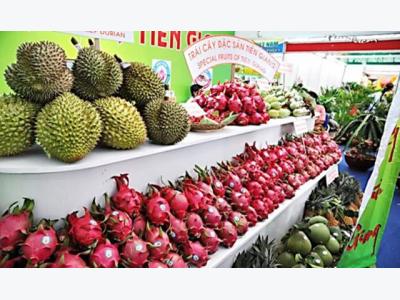Vietnams vegetable and fruit exports try to maintain sustainable growth

Vietnam Vegetable and Fruit Association reported that the domestic vegetable and fruit industry will face obstacles in maintaining sustainable growth in export value at the current high level, but Vietnam still makes effort to maintain sustainable growth of export value.
Total national export value of vegetables and fruits reached US$2.4 billion in 2016, a year-on-year increase of 30%. Export value is expected to increase to US$3 billion this year. The year 2016 witnessed impressive growth in the export value of vegetables and fruits, as a result of which their export value exceeded their export value of rice.
Vietnam’s fruit and vegetable products were exported to 60 countries and territories, but trade promotion and steps to maintain the freshness of these products have not been developed according to expectations, the association said. For instance, local vegetable and fruit products were sold at only a few places in California and New York in the US, partly due to poor trade promotion, it said.
US apples had, however, entered all distribution systems -- from traditional markets to modern trading centres -- because the products retained their freshness for six months and the US Department of Agriculture ensured funds were contributed by local enterprises of importing counties for trade promotion activities.
Meanwhile, Vietnamese vegetable and fruit products remained fresh only for a few days, the association said, adding that it expected that a contribution from the state’s credit package worth VND100 trillion for hi-tech agriculture would create favourable conditions for development of processing technology for Vietnamese vegetable and fruit products.
Nguyen Huu Đat from the Vietnam Vegetable and Fruit Association said it was necessary to have preferential loans for the development of modern processing lines that met international standards at enterprises.
Additionally, the state should have preferential loans for research institutes, centres and colleges to research and develop vegetable and fruit seeds and plant protection products, such as pesticides and herbicides. The research facilities also required cooperation with enterprises and producers to ensure efficiency in vegetable and fruit production.
Nguyen Dinh Tung, general director of local professional fruit exporter VINA T&T, said the vegetable and fruit industry needed funds amounting to VND500 billion for current projects on researching preservation technology for farming products.
He expected that after processing, Vietnam’s major fruit products, such as dragon fruit and longan, could be kept fresh longer than the current period of 1-2 months. The association also said local fruit exporters should continue paying attention to food hygiene and safety as they have done over the past eight years, chinhphu.vn reported.
If importing countries identified even one case where food hygiene and safety regulations were violated, they would gradually increase the percentage of imported fruits inspected from 5% of total imported batches, at present, to 50% or even 100%. This inspection would take time, affecting consumption and quality of fruits in the export market, leading to losses and eventually a loss of the enrite market. It would also affect local vegetable and fruit production.
Có thể bạn quan tâm
 Most of chicken imports come from US
Most of chicken imports come from US Vietnam imported around 22,500 tons of chicken valued at US$19.8 million from early this year to March 15, according to the General Department of Vietnam Custom
 PM urges increasing rice added-value
PM urges increasing rice added-value Prime Minister Nguyen Xuan Phuc has urged ministries, sectors and localities to work hard to enhance the added-value of Vietnamese rice.
 Institutional barriers for Vietnamese rice removed
Institutional barriers for Vietnamese rice removed Although the rice industry has achieved remarkable growth over the past three decades, the industry is now facing with many challenges and institutional barrier